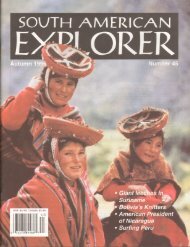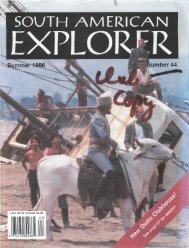Number 30 - South American Explorers
Number 30 - South American Explorers
Number 30 - South American Explorers
Create successful ePaper yourself
Turn your PDF publications into a flip-book with our unique Google optimized e-Paper software.
20 SOUTH AMERICAN EXPLORER<br />
event, it certainly furnishes material for speculation.<br />
Made of fine-grained clay, the warrior's legs are bound,<br />
an example of a practice possibly copied from the fierce<br />
war-like Carib, a people who migrated down the River<br />
Magdelena into the interior of Colombia around A.D.<br />
1,000. The custom of binding the legs until the lower<br />
extremities swelled up was a much-admired deformity,<br />
one that may not have represented beauty enhancement<br />
so much as rank or position in the community.<br />
Body alterations, clothing, jewelry, body painting, and<br />
other marks of external distinction offered instant recognition<br />
of social status to a non-literate society. Art,<br />
too, with its symbols and forms, developed over time<br />
into a language serving early man as a means of communication<br />
with other men as well as between the community<br />
and their gods. As society grew more complex,<br />
art forms reflect increasingly skillful technologies and<br />
ever more useful and meaningful forms. Not all cultures,<br />
of course, developed art to a high level of excellence,<br />
or at thesame speed. But all practiced some form<br />
of art. Nevertheless, the systematic study of the art of<br />
ancient cultures in Colombia is very recent. We have yet<br />
to develop a clear idea of the immense diversity.<br />
The La Tolita/Tumaco urn lid, Figure Four, has an<br />
altogether different tone, distinguished by drama and a<br />
rare narrative interest. An enormous feline, larger than<br />
life, stocky and fearsome, dominates the scene. It stands<br />
over the small, recumbent form of a woman who lies<br />
between its front legs. This piece belongs to a small<br />
group of ceramics which feature an over-sized jaguar in<br />
association with humans. One of Colombia's great early<br />
archaeologists, Reichel-Dolmatoff, was deeply interested<br />
in the mythology of present-day native populations.<br />
He has left some thought-provoking comments,<br />
suggesting that this group of ceramics represents the<br />
spirit master of the animal "writ large," artistically portraying<br />
the idea of spirituality, other-worldliness, power<br />
and scope beyond the norm, connected wilh shamanistic<br />
perceptions. Reichel-Dolmatoff participated in the<br />
hallucinogenic}>«/e-drinking ritual, to experience an altered<br />
state of mind in which he thinks ancient craftsmen<br />
ABOVE, Feline effigy urn lid, 200 B.C.-200 A.D., La<br />
Tolita/Tumaco culture, Colombia/Ecuadorian border.<br />
Denver Art Museum.





